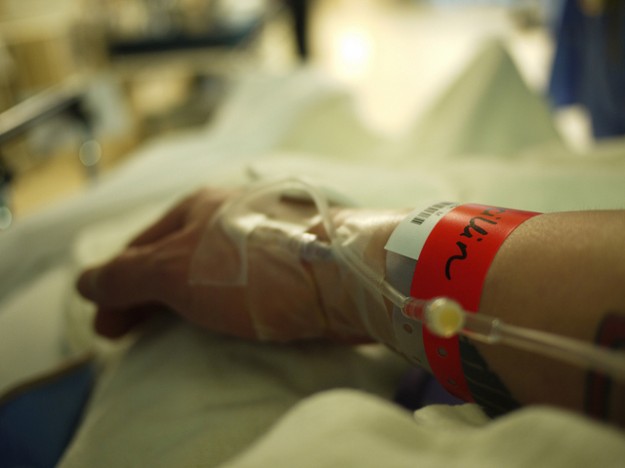Malignant Hyperthermia — Diagnosis and Treatment
While anesthesia has become safer and safer in past years, there are some rare but dreaded complications, which can rapidly worsen the state of the patients and can even lead to their death. A prospective physician should be familiar with these emergencies. An important complication in the context of anesthesia is malignant hyperthermia, an acute functional disorder of the skeletal muscles. Here, you can learn how it develops and how malignant hyperthermia is treated.
Table of Contents
Are you more of a visual learner? Check out our online video lectures and start your Emergency Medicine course now for free!

Image: “” by Thirteen Of Clubs. License: CC BY-SA 2.0
Calcium Metabolism Derailment
Malignant hyperthermia is one of the most dreaded complications in general anesthesia. It can be triggered by certain anesthetics and, if not treated, is lethal in 70 – 80% of cases. In most cases, it develops during narcosis. However, it might also occur in post-surgical cases.The cause of malignant hyperthermia is a genetic defect in the calcium metabolism of the skeletal muscle cells. It is assumed that there is a mutation in the gene, which codes for the intracellular ryanodine receptor. This receptor makes for the release of calcium out of the sarcoplasmatic reticulum of the muscle cell, which eventually leads to muscle contraction.
In the case of malignant hyperthermia, a ryanodine receptor defect leads to continuous muscle contraction. The re-absorption of calcium into the sarcoplasmatic reticulum, and the relaxation phase associated with it, fail to occur.
The consequence is an increased cellular metabolism (hypermetabolism) with a subsequent massive increase in CO2, tissue hypoxia, increased warmth production, and lactate acidosis. If not treated, cellular decay with an increase in creatine kinase (CK) and myoglobinuria.
These Anesthetics Require Careful Use
Substances that may trigger malignant hyperthermia include: inhalation anesthetics (halothane, enflurane and isoflurane etc.) and the muscle relaxant, succinylcholine. Stress may also be a trigger. Furthermore, ketamine and local anesthetics of the amide type are discussed as possible trigger substances.The following are considered ‘safe anesthetics’ for patients with previously diagnosed malignant hyperthermia:
- Laughing gas (nitrous oxide)
- Barbiturates
- Benzodiazepines
- Etomidate
- Propofol
- Ketamine
- Opioids
- Non-depolarizing muscle relaxants
Recognizing Malignant Hyperthermia
The most frequent early signs of malignant hyperthermia include tachycardia or tachycardic cardiac dysrhythmia in almost 90% of the cases. Unfortunately, this is very unspecific and is often misinterpreted as too low depth of anesthesia.A more specific early symptom is hypercapnia. Within a few minutes, the CO2-partial pressure can rise to the three- or fourfold. Indirectly, this becomes apparent through the warming of the CO2-absorber. A direct indicator is capnometry, which is part of standard monitoring in surgery and in the intensive care unit. Also, muscular rigor, acidosis and hyperkalemia are early signs.
Masseter spasms and rigor of the remaining muscles are specific for a succinylcholine induced malignant hyperthermia.
Masseter spasms at the beginning of anesthesia induction are always suspicious and should lead to the termination of the anesthesia administration and the initiation of further diagnostics and therapy. As a late sign, the creatine kinase concentration and body temperature rapidly rise (up to 1° Celsius in 5 minutes). Initially, blood pressure is often elevated and, eventually, it is decreased as a sign of circulatory failure.
Emergency Therapy of Malignant Hyperthermia
Immediate action with initial suspicion of malignant hyperthermia includes removing the trigger substances, terminating surgery as soon as possible, and, if necessary, change to safer anesthetics (see above).Ventilation should be changed to hyperventilation with 100% oxygen and three- to fourfold increased respiratory minute volume. Dantrolene, a muscle relaxant that inhibits the release of calcium in the sarcoplasmic reticulum, is administered intravenously to terminate the continuous muscular contraction.
Symptomatic measures include the balance of the acidosis with sodium bicarbonate, the cooling of the patient, volume loading and electrolyte balance. If myoglobinuria or increased serum-myoglobin occurs, forced diuresis will reduce the complication of a crush kidney. Unless clearly contraindicated, the tachycardia may be treated with the administration of beta-blockers.
Diagnosis of Malignant Hyperthermia
Malignant hyperthermia can be detected with a muscle biopsy and subsequent in-vitro-contracture test with caffeine and halothane. If a predisposition for malignant hyperthermia is present, there is increased contraction behavior, under the influence of caffeine and halothane.The test should be performed after an incident during narcosis or post-surgically if relatives are affected by malignant hyperthermia (family history in preoperative discussion).
If malignant hyperthermia is detected, the patient should be informed about the existing risk of narcosis and an allergy should be noted in the chart, along with clear annotation of the allergy to minimize future risk.
Comentários
Enviar um comentário